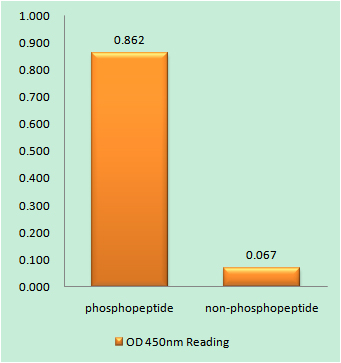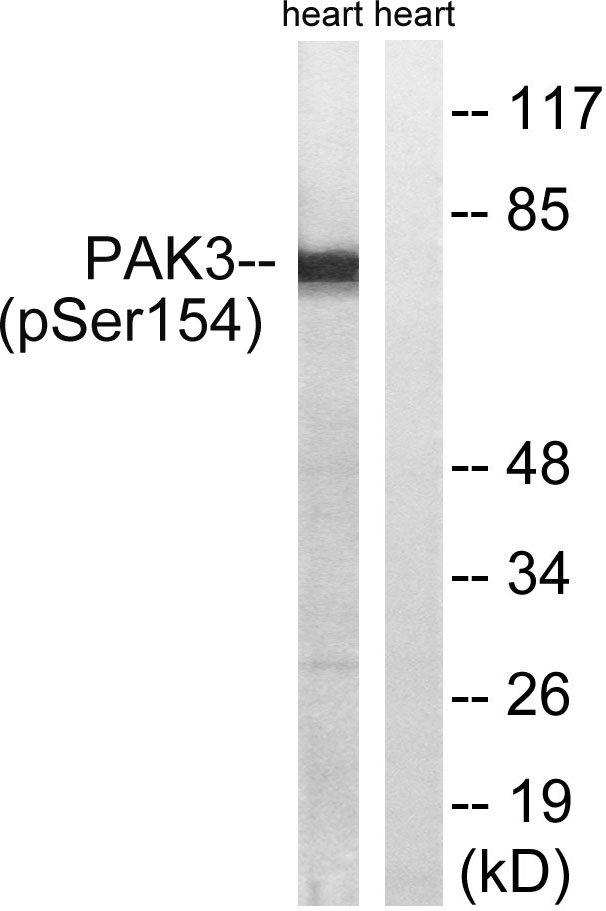PAKβ (phospho Ser154) Polyclonal Antibody
- Catalog No.:YP0795
- Applications:WB;IHC;IF;ELISA
- Reactivity:Human;Mouse;Rat
- Target:
- PAKβ
- Fields:
- >>ErbB signaling pathway;>>Ras signaling pathway;>>Axon guidance;>>Focal adhesion;>>T cell receptor signaling pathway;>>Regulation of actin cytoskeleton;>>Pathogenic Escherichia coli infection;>>Salmonella infection;>>Human immunodeficiency virus 1 infection;>>Renal cell carcinoma
- Gene Name:
- PAK3
- Protein Name:
- Serine/threonine-protein kinase PAK 3
- Human Gene Id:
- 5063
- Human Swiss Prot No:
- O75914
- Mouse Gene Id:
- 18481
- Mouse Swiss Prot No:
- Q61036
- Rat Gene Id:
- 29433
- Rat Swiss Prot No:
- Q62829
- Immunogen:
- The antiserum was produced against synthesized peptide derived from human PAK3 around the phosphorylation site of Ser154. AA range:121-170
- Specificity:
- Phospho-PAKβ (S154) Polyclonal Antibody detects endogenous levels of PAKβ protein only when phosphorylated at S154.
- Formulation:
- Liquid in PBS containing 50% glycerol, 0.5% BSA and 0.02% sodium azide.
- Source:
- Polyclonal, Rabbit,IgG
- Dilution:
- WB 1:500 - 1:2000. IHC 1:100 - 1:300. ELISA: 1:20000.. IF 1:50-200
- Purification:
- The antibody was affinity-purified from rabbit antiserum by affinity-chromatography using epitope-specific immunogen.
- Concentration:
- 1 mg/ml
- Storage Stability:
- -15°C to -25°C/1 year(Do not lower than -25°C)
- Other Name:
- PAK3;OPHN3;Serine/threonine-protein kinase PAK 3;Beta-PAK;Oligophrenin-3;p21-activated kinase 3;PAK-3
- Observed Band(KD):
- 72kD
- Background:
- The protein encoded by this gene is a serine-threonine kinase and forms an activated complex with GTP-bound RAS-like (P21), CDC2 and RAC1. This protein may be necessary for dendritic development and for the rapid cytoskeletal reorganization in dendritic spines associated with synaptic plasticity. Defects in this gene are the cause of non-syndromic mental retardation X-linked type 30 (MRX30), also called X-linked mental retardation type 47 (MRX47). Alternatively spliced transcript variants encoding different isoforms have been identified. [provided by RefSeq, Apr 2016],
- Function:
- catalytic activity:ATP + a protein = ADP + a phosphoprotein.,cofactor:Magnesium.,disease:Defects in PAK3 are the cause of mental retardation X-linked type 30 (MRX30) [MIM:300558]; also called X-linked mental retardation type 47 (MRX47). Mental retardation is a mental disorder characterized by significantly sub-average general intellectual functioning associated with impairments in adaptative behavior and manifested during the developmental period. Non-syndromic mental retardation patients do not manifest other clinical signs.,enzyme regulation:Activated by binding small G proteins. Binding of GTP-bound CDC42 or RAC1 to the autoregulatory region releases monomers from the autoinhibited dimer, enables phosphorylation of Thr-436 and allows the kinase domain to adopt an active structure.,function:Key regulator of synapse formation and plasticity in the hippocampus.,PTM:Autophosphorylated whe
- Subcellular Location:
- Cytoplasm .
- Expression:
- Restricted to the nervous system. Highly expressed in postmitotic neurons of the developing and postnatal cerebral cortex and hippocampus.
- June 19-2018
- WESTERN IMMUNOBLOTTING PROTOCOL
- June 19-2018
- IMMUNOHISTOCHEMISTRY-PARAFFIN PROTOCOL
- June 19-2018
- IMMUNOFLUORESCENCE PROTOCOL
- September 08-2020
- FLOW-CYTOMEYRT-PROTOCOL
- May 20-2022
- Cell-Based ELISA│解您多样本WB检测之困扰
- July 13-2018
- CELL-BASED-ELISA-PROTOCOL-FOR-ACETYL-PROTEIN
- July 13-2018
- CELL-BASED-ELISA-PROTOCOL-FOR-PHOSPHO-PROTEIN
- July 13-2018
- Antibody-FAQs
- Products Images

- Enzyme-Linked Immunosorbent Assay (Phospho-ELISA) for Immunogen Phosphopeptide (Phospho-left) and Non-Phosphopeptide (Phospho-right), using PAK3 (Phospho-Ser154) Antibody

- Immunohistochemistry analysis of paraffin-embedded human brain, using PAK3 (Phospho-Ser154) Antibody. The picture on the right is blocked with the phospho peptide.

- Western blot analysis of lysates from rat heart, using PAK3 (Phospho-Ser154) Antibody. The lane on the right is blocked with the phospho peptide.



